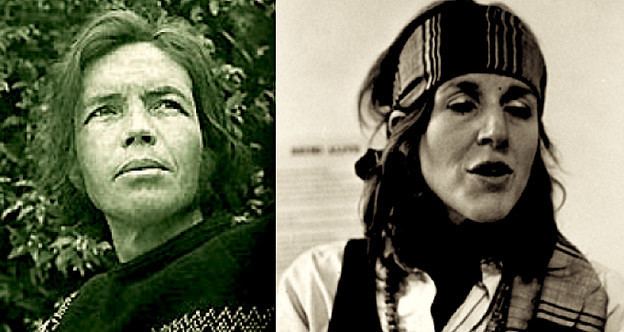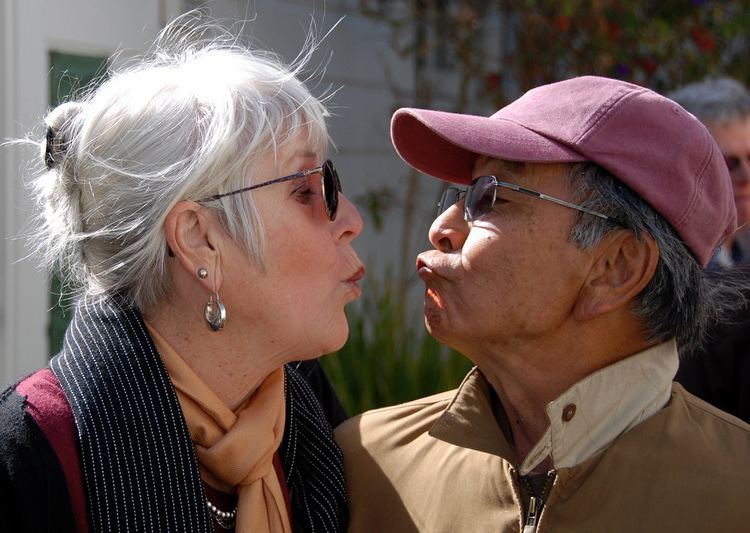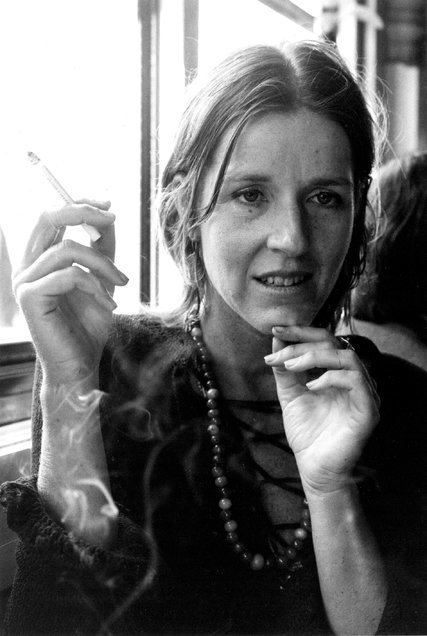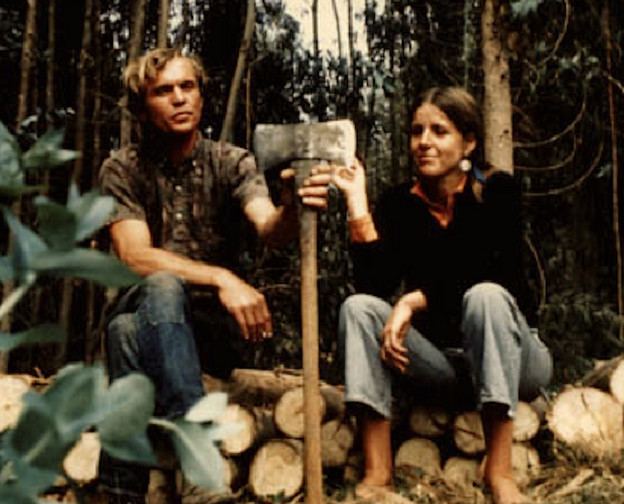Name Joanne Kyger Role Poet | Awards National Poetry Series | |
 | ||
Books As ever, Strange big moon, About Now: Collected Poems, Just space, On Time: Poems 2005‑2014 Similar People Gary Snyder, Michael Rothenberg, William Randolph Hearst III | ||
Lunch poems joanne kyger
Joanne Kyger (November 19, 1934 – March 22, 2017) was an American poet. The author of over 30 books of poetry and prose, Kyger was associated with the poets of the San Francisco Renaissance, the Beat Generation, Black Mountain, and the New York School.
Contents
- Lunch poems joanne kyger
- Joanne kyger san francisco public library
- Early Life and Education
- San Francisco Renaissance and the Beats
- Japan and India
- Early Successes
- The Bolinas Years
- Mexico
- Later Life and Death
- References

Although Kyger is often characterized as a prominent female Beat poet in the predominately male inner circle of Beat Generation writers, she never considered herself as belonging to the Beat movement. Nor did she formally identify with any other movement; her work invokes various schools of poetry without belonging to any of them. In Reconstructing the Beats, Amy L. Friedman calls Kyger “an important link between several major axes of American poetry and writing in the twentieth century.” Linda Russo, in the webzine Jacket’s edition devoted to Kyger, notes that “there is no one way to talk about her work except as that of a singular individual.”

Kyger’s early poetry was influenced by Charles Olson’s “projective verse” concept of letting breath and open construction, rather than rhyme and syntax, guide poetic composition. This influence continued to shape her mature work. In a 2010 interview Kyger says, “You want to make it so that someone could say it. I try to ‘score’ the lines for the page with that in mind, the breathing, the timing.” Unlike Olson, notes Dale Smith in his essay "Joanne Kyger and the Narrative of Every Day," Kyger “focuses on events and happenings, moving herself out of the way as a kind of recording instrument . . . faithful to specific moments in time and attendant to the many spirits or moods of landscape.” In a 2007 review of Kyger’s book About Now: Collected Poems, Lewis MacAdams describes Kyger as from the “School of Backyard Poets, who look out their kitchen windows and see the universe.”
Kyger's poems emerged from a daily literary practice of recording thoughts, events, and dreams. Most of the poems are dated, either in the title or at the end. Much like journals, they include everything from philosophical musings to the weather. Themes—arising from her practice of Zen Buddhism, study of consciousness, explorations of ancient Greek and Native American mythologies, frequent travels to Mexico, observations of the natural landscape, and daily life in a small coastal town—continue from book to book, like installments in an autobiography. In a 2011 interview, Kyger says, “I think of notebook writing like a practice—I try and do it whether I have anything good or bad or interesting to say. And the chronology becomes the narrative, a history of a writing ‘self.’”

Joanne kyger san francisco public library
Early Life and Education

Joanne Elizabeth Kyger was born on November 19, 1934, in Vallejo, California, to Jacob Kyger, a Navy captain, and Anne (Lamont) Kyger, a Santa Barbara, California, city employee of Canadian descent. Kyger moved often, living in China, California, Illinois, and Pennsylvania, until the age of 14, when the family (including Kyger’s two sisters) settled in Santa Barbara. Her parents separated permanently in 1949.

Kyger’s first published poem appeared in her school’s literary magazine when she was five. At Santa Barbara High School, Kyger co-edited the features column of the school newspaper with Leland Hickman. In 1952, she enrolled at Santa Barbara College (later University of California, Santa Barbara), where she studied philosophy and literature and started the school’s first literary magazine. Renowned critic Hugh Kenner introduced her to the works of Modernist poets, such as W. B. Yeats and William Carlos Williams, while Paul Wienpahl introduced her to the works of Wittgenstein and Heidegger. In her 2015 notes from an earlier interview, Kyger recalls that the philosophers inspired her interest in Zen Buddhism: “Heidegger had come to the study of 'nothing.' Then I found D. T. Suzuki's book on Japanese Zen and I thought, Oh! this is where you go with this mind. This 'nothing' is really 'something.’” Kyger left the university in 1956, one freshman biology course short of a degree in philosophy and literature.
San Francisco Renaissance and the Beats

Kyger moved to San Francisco 1957 at the age of 22, where she met Richard Brautigan, who introduced her to City Lights bookstore and the bohemian neighborhood of North Beach. Working in Brentano's bookstore in the City of Paris department store by day and sharing her poetry at The Place bar by night, Kyger became a part of the literary scene that included Allen Ginsberg, Jack Kerouac, Michael McClure, Kenneth Rexroth, John Wieners, and former Black Mountain students William McNeill, Ebbe Borregaard, and Michael Rumaker. San Francisco Renaissance poets Robert Duncan and Jack Spicer became Kyger's mentors, and she was invited to join the Sunday Meetings, presided over by Spicer, where she read her poems aloud.
In 1958, Kyger met Gary Snyder, whom she would marry in 1960. Snyder introduced Kyger to Philip Whalen, and they became lifelong friends, sharing the sensibilities that defined their similar poetic styles. Kyger’s print debut, "Tapestry #3," appeared in Spicer's mimeographed magazine J No. 4 in 1959, and she gave her first public poetry reading on March 7, 1959, at the Beer and Wine Mission. During this period she moved to the East-West House, a communal center for those interested in Asian studies, and studied with Shunryu Suzuki Roshi at the Sokoji Temple in Japantown.
Japan and India
On January 30, 1960, Kyger left California by ship to join Snyder in Kyoto, Japan. Since Japanese customs frowned upon unmarried couples living together, they were married at the American Consulate in Kobe on February 23, three days after Kyger arrived in Japan, followed by a Zen marriage ceremony performed at Daitoku-ji in Kyoto five days later. While living in Japan, Kyger wrote poetry, studied Buddhism with Ruth Fuller Sasaki at Ryosen-an—the zendo of the First Zen Institute's Kyoto branch, learned flower arranging, taught English, and acted in small roles in Japanese B movies.
In December 1961, Kyger and Snyder traveled to India with Allen Ginsberg and Peter Orlovsky. They met with the Dalai Lama in March 1962. The following month, the Kyger and Snyder continued their travels in Singapore, Vietnam, and Hong Kong.
During this period, in addition to writing poems that would be included in her first book, Kyger recorded her travels in diaries, which were published in 1981 as The Japan and India Journals 1960–1964. The autobiographical text—which chronicles, in part, her growing frustration with Snyder’s expectations and Ginsberg’s antics—is considered an important document of the Beat era, offering a rare female perspective on the male-centric movement. In the foreword of the 2000 reissue of the book, Anne Waldman calls it “one of the finest books ever in the genre of ‘journal writing’” and “a surprisingly (surreptitiously) feminist tract as well: woman artist struggles for identity and independence in the 1960s.”
Early Successes
In January 1964, Kyger left Snyder to his studies in Japan and returned alone, her marriage disintegrated, to San Francisco. She met painter and student of Buddhism Jack Boyce and married him in 1965 after divorcing Snyder. The same year, she participated in the Berkeley Poetry Conference, meeting poets Charles Olson and Ted Berrigan. She edited an edition of Wild Dog magazine, and The Tapestry and the Web, her first book of poems—with drawings by Boyce—was published.
The following year, Kyger and Boyce visited Europe. They settled in New York City for a year, befriending poets Anne Waldman and Lewis Warsh. There, Kyger associated with New York School poets including Michael Brownstein, Larry Fagin, Tom Clark, and Berrigan. She was briefly associated with the Yippie movement.
In 1967, Kyger received a residency at the National Center for Experiments in Television in San Francisco. Drawing on Descartes's Discourse on the Method, she translated the philosopher's work into a poem-video titled "Descartes and the Splendor of. A Real Drama of Everyday Life. In Six Parts." The video, Kyger’s only one, aired in November 1968. During this period, she met Carlos Castaneda and Michael Harner and discussed the illusions of a peyote vision she had in 1959.
The Bolinas Years
At the end of the '60s, Kyger joined other poets following the back-to-the-land movement. In 1969 she settled in the small coastal town of Bolinas, California, with Jack Boyce. The community and the landscape of Bolinas would feature prominently in her work from that point on. Among her friends, neighbors, and collaborators attracted to the liberal, arts-based community were poets Robert Creeley, Bill Berkson, Jim Carroll, Bobbie Louise Hawkins, Alice Notley, Lewis MacAdams, Duncan McNaughton, and Aram Saroyan, as well as artists Ken Botto, Joe Brainard, Tom Field, and Arthur Okamura.
In 1970, she separated from Jack Boyce, and the following year, she bought a house on the Bolinas Mesa, which she shared with Peter Warshall. In 1971, she accompanied Warshall and a group of Harvard students to Puerto Rico to study a colony of rhesus monkeys, and embarked on a Carl Jung–inspired study of dreams that became Desecheo Notebook, published the same year. Kyger and Warshall also traveled to Chiapas, Mexico. Kyger's All This Every Day, was written at that time and published in 1975, the year her relationship with Warshall ended.
In the mid-70s, she began teaching occasionally at the New College of California, an activity she continued until 2001. In 1977, she also became a regular teacher in the summer writing program at the Jack Kerouac School of Disembodied Poetics at Naropa University in Boulder, Colorado. There she met Canadian-American writer, artist, and naturalist Donald Guravich, who would become her lifelong partner and collaborator. He joined her permanently in Bolinas in 1978 and they were married in 2013. They lived in Bolinas until her death in 2017.
Mexico
Beginning in the mid-80s and continuing for almost three decades, Kyger and Guravich frequently traveled to Mexico, often to Oaxaca, but also to Quintana Roo, Yucatán, Chiapis, Patzcuaro, Michoacan and Veracruz. These trips provided inspiration for several volumes of Kyger's poetry, including Phenomenological, an edition in the series A Curriculum of the Soul that explores the nature of consciousness.
Later Life and Death
Kyger became the Wednesday editor of the Bolinas Hearsay News in 1984, a post she held for over 20 years. During this period, she continued teaching occasionally at Naropa University and the New College, as well as teaching at Mills College and offering writing classes in Bolinas. In 2000, her 1981 collection of autobiographical writings was reissued as Strange Big Moon: Japan and India Journals, 1960–1964. More recent poetry collections include Again: Poems 1989–2000, As Ever: Selected Poems, The Distressed Look, and God Never Dies. In 2006 she was awarded a grant from the Foundation for Contemporary Arts Grants to Artists Award. About Now: Collected Poems was published in 2007 by the National Poetry Foundation and received the 2008 PEN Oakland Josephine Miles National Literary Award for Poetry. On Time: Poems 2005–2014, one of her last book of poems, was published by City Lights in 2015. Kyger describes her work in her 2005 artist statement:
The shape of the day, the words of the moment, what's happening around me in the world of interior and exterior space—these are my writing concerns. Living in a semi-rural environment the cast of characters in my poems are often the quail, deer, raccoons, coyote bush, oaks, the ocean, the weather, and a few treasured friends. All are equally valid in the environment of place. Some talk more than others. My attention to writing is a daily practice, which then builds an accumulative narrative of chronology. Which ends up as the story of one's life. An historical sense of 'self,' breathing and experiencing what is common to every human—the local, the ordinary, the non-motivated sense of just 'being.' One is also aware of the accumulations of lineage of all those writing persons who have come before and to whom one owes the inheritance of this written moment.
Kyger died at age 82 on March 22, 2017, at her home in Bolinas, California, from lung cancer, in the company of her husband, Donald Guravich. Kyger had been working on a new book, There You Are: Interviews, Journals, and Ephemera. It was published in September 2017 by Wave Books.
